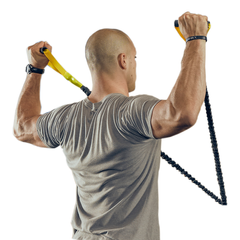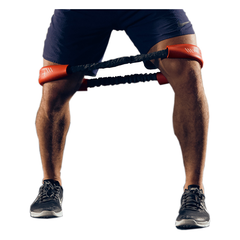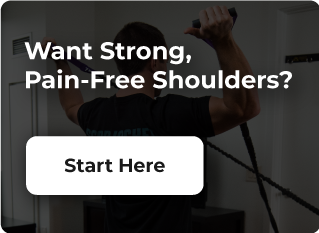Is there anything we aren’t divided over these days?
Politics, religion, nutrition, what color was that dress (clearly black and blue), and then of course…
The Kipping Pull-up!
A movement that’s become a staple among HIIT training communities and garage gyms.
First off, lots of fingers get pointed at the lying cheaters missing out on all the pull-up gains. For this, I believe it’s time to accept different training goals and methodologies.
However, the bigger question around the safety of the kip is an important one.
Seeing that we developed a company around building stronger and pain free shoulders – I thought it was time we weighed in on the Kipping Debate!
(And before we jump into it, anyone with shoulder pain needs to rehab that before getting after their kip. We happen to have a really great solution for that…Fix Shoulder Pain Here.)
The Benefits of the Kip
I will agree with the critics that the kipping motion can be a cause of injury, but for the same reason that a move like the push press can increase injuries. It allows an athlete to increase volume and use momentum to push through mobility restrictions.
So the first question: Does the kipping pull-up add enough benefit to outweigh the increased injury risk?
For the person with zero interest in pushing that level of intensity, then no, it’s simply not worth it….
But for someone feeling the mojo to push their performance, it can develop athleticism, coordination, overall strength, and an sense of accomplishment.
For those reasons, those who want it, then “Go for it!”
But should every noob be allowed to swing like a banshee? Definitely not! Neither should the Games hopeful without exhibiting the following prerequisites (none of which are the commonly cited prerequisite of a certain number of strict pull-ups.)
When To Get Your Kip On…
1. Do You Have the Mobility?
One of the biggest injury issues related to the kipping motion is the necessary shoulder mobility for the bottom of the swing (not only shoulder mobility, but you need thoracic extension, and good scap movement as well).
Without the necessary mobility, your shoulder ends up slamming into the end range with speed and load, which over the course of several reps can definitely cause some shoulder pain issues.
Additionally, there are potential labrum issues related to the downswing of the kip.
The labrum is especially at risk by loads placed on the biceps tendon during extreme abduction and external rotation. This is referred to as the peel back mechanism, a common issue for baseball pitchers.
We have all seen the nasty bent elbow pull-up to compensate for poor mobility of the thoracic spine, shoulder and biceps, and this does indeed look eerily similar to the torsions generated by baseball players in their layback. Yet another reason to work on mobility before the kip swing.
Thus, before introducing the kip, it would be wise to checkout the end range of your shoulder. To measure this, lay on a foam roller and take the arms overhead. Your arms should be able to clear the ears without an extreme arch in your back.

2. Do You Have Shoulder Stability?
A strength prerequisite is the goal of applying a strict pull-up governor on anyone wanting to try kipping. But, that is pretty non-specific when looking at the overall injury risk for the movement.
If you are going to hurt yourself doing pull ups, it will be while coming down not going up. That’s because the forces can be large just dropping into the bottom position.
Better than looking at the ability to do any number of strict pull-ups, look at the ability to come down under control. This doesn’t mean a super slow rep, but is there smooth controlled movement from one rep to the next. Typically if an athlete is missing shoulder stability their kip will look jerky and rigid.
3. Are You Overloading?
The third issue with the kipping pull-up relates to the extra volume that gets placed on the shoulder. This isn’t necessarily a bad thing, it’s how strength is built, but it is something that needs to be monitored.
First, look for any meltdown in technique. Two common signs are:
1. Is the palm gripping the bar?
2. Is there still a fluid kip?
Once these things are lost, it is safe to say that shoulder position has been lost as well, and it’s time to look for scaling options.
Second, keep track of weekly volumes. Just like any aspiring runner shouldn’t go out for a 20 miler after just 1-week of training, someone who has just got their kipping pull-up shouldn’t throw down Fran on their first go. Follow the 10% rule just like a runner would, which states: never increase your weekly mileage by over 10%.
Applying this to the kipping pull-up….
1. Develop the movement outside the context of a timed WOD. This removes the competitive pressure to do more faster.
2. Start conservative and build progressively! Limit your kipping pull-ups to only 5 per workout and include them in no more than 3 workouts per week. So your first week working on the movement should be roughly no more than 15 reps. Then add a 10% increase every week, which over the course of 12 weeks puts you at roughly 50 reps per week and probably a good baseline to start adding them into metcons.
Building the Bulletproof Shoulder
I hope this has provided a bit more context around the kipping pull-up and its application. If you are missing any of these prerequisites the Crossover Symmetry System can help. We offer 5 programs that will improve stability, mobility, and motor control of the shoulder, which I have pointed out are necessary for high level shoulder performance. You can learn more about what makes us different right here: How CS Works
 Shoulder Packages
Shoulder Packages
 Hip & Core Package
Hip & Core Package
 NEW - Crossover TORQ
NEW - Crossover TORQ
 Bundles
Bundles
 Accessories
Accessories

























